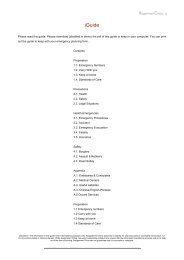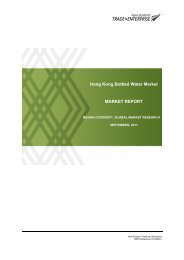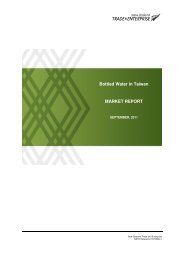China Country Brief - December 2011.pdf - PrcLive
China Country Brief - December 2011.pdf - PrcLive
China Country Brief - December 2011.pdf - PrcLive
Create successful ePaper yourself
Turn your PDF publications into a flip-book with our unique Google optimized e-Paper software.
SECTOR OPPORTUNITIES<strong>China</strong> offers significant business opportunities for New Zealand companies. Sectorswhere New Zealand companies may have a value proposition that is commerciallyfeasible in the <strong>China</strong> market include the following.Food and BeveragesChinese consumers are looking for safe, quality products. As disposable incomes riseconsumers can afford better quality products and are more focused on wellbeing. Theyare increasingly looking for the healthiest and freshest quality foods. New Zealand’sreputation as a clean and green environment, with an unblemished food safety record,means our products have an edge. In addition, the Chinese are increasingly looking forconvenience products. Wet markets and produce markets are losing their dominance asmore consumers are drawn to hypermarkets and restaurants. This opens up significantopportunities for New Zealand’s quality foods.New Zealand already exports significant volumes of dairy products: mainly bulk milkpowder but also cream, cheese, butter and yoghurt. In the year to September 2011, NewZealand’s dairy exports to <strong>China</strong> were worth NZ$2.13 billion. New Zealand also exportslarge volumes of meat, mainly low value lamb and offal. There are niche opportunities tosupply higher value-added meat cuts to the retail and hotel, restaurant and institutional(HRI) sectors in major cities. New Zealand’s seafood exports to <strong>China</strong> have grown by 84percent in the 12 months to September 2011 and <strong>China</strong> is now New Zealand’s secondlargest export market for fish and seafood. This is predominantly for manufacturing butthere is also a growing component of high value fresh seafood.The Chinese market for domestic and imported wine has been developing rapidly, thoughit is still a small part of the alcoholic drinks market. The largest market for imported wine is“on-premise”, at top-end hotels, restaurants, bars and nightclubs. Four and five-starhotels, Western restaurants and upscale local chain restaurants generally carry aselection of local and imported wines. The retail market for imported wines is alsogrowing. Foreign supermarket chains normally have a wine corner at outlets located inmiddle to high income districts. High-end domestic department stores also carry importedwine, as do independent wine shops.InfrastructureWhile <strong>China</strong> has made huge efforts to upgrade its transport infrastructure in the developedcoastal provinces, the central and western regions are still far from being well connectedto the industrial hubs along the coast. Accordingly, the Chinese government hasdeveloped initiatives to push development westwards. While <strong>China</strong>'s road and rail networkhas high potential for expansion, the airport sector has the biggest need for upgrading.Covering 9.6 million sq km (about the same land size as the US), <strong>China</strong> operated only 1466/Exporter Guide | <strong>China</strong> | <strong>Country</strong> <strong>Brief</strong> | <strong>December</strong> 2011












